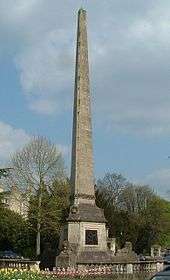Royal Victoria Park, Bath
| Royal Victoria Park | |
|---|---|
|
The park overlooked by the Royal Crescent | |
| Location | Bath England |
| Coordinates | 51°23′09″N 2°22′13″W / 51.3858°N 2.3704°WCoordinates: 51°23′09″N 2°22′13″W / 51.3858°N 2.3704°W |
| Area | 57 acres (23 ha) |
| Created | 1830 |
| Operated by | Bath and North East Somerset |
| Status | Open all year |
Royal Victoria Park is located in Bath, England. It was opened in 1830 by the 11-year-old Princess Victoria,[1] it was the first park to carry her name, and includes an obelisk dedicated to her. It was privately run as part of the Victorian public park movement until 1921 when it was taken over by the Bath Corporation.
The park is overlooked by the Royal Crescent and consists of 57 acres (231,000 m²) with attractions that include a skateboard ramp, tennis, bowling a putting green and 12 and 18 hole golf course, a boating pond, open-air concerts, a children's play area and a 9-acre (36,000 m²) botanical garden.
It has received a Green Flag award, the national standard for parks and green spaces in England and Wales and is Grade I registered by English Heritage on the National Register of Historic Parks and Gardens.[2][3]
The Botanical Gardens

The Botanical Gardens were formed in the north-west area of the park in 1887. It contain one of the finest collections of plants on limestone in the West country. The replica of a Roman Temple in the gardens was used at the British Empire Exhibition at Wembley in 1924.[5]
Great Dell
To the north of the Botanical Gardens is the Great Dell, a sunken wooded area alongside Weston Road. It is a former stone quarry planted out in the 1840s with a collection of unusual trees, including some large north American conifers.[6]
2007 restoration
In 2007 a programme of reconstruction and restoration was undertaken by Bath and North East Somerset Council and supported by the Heritage Lottery Fund. This included the renovation of two Medici lion statues on plinths each side of the Queen’s Gate entrance to the park, replacing the original iron armatures inside the limbs, returning them to their bronze colour, and giving each a gilt ball under its front paw. Further work will add two 8 feet (2.4 m) cast iron replicas of the original lanterns and the replacement of the decorative iron gates to the three main entrances to the park. The original gates were removed, along with all the railings around the park, as part of a Second World War national scrap metal campaign.[7]
Further works involved the reinstatement of over a mile of perimeter railings, the restoration of the bandstand, the reforming of three sets of park gates, work to the Royal Crescent Ha-ha, and the extension of the Temple of Minerva to form a small interpretation centre. These works coincided with significant works to the planting throughout the park.
Gallery
- Tree carving in the Botanical gardens
- Statue in the Great Dell
- Temple of Minerva, constructed at Wembley in 1924 for the British Empire Exhibition, rebuilt in the Botanic gardens in 1926
- Duck pond
- Gates to the Botanical Gardens
 Children's play area
Children's play area
References
- ↑ "Royal Victoria Park, Bath, Bath, England". Parks & Gardens UK. Parks and Gardens Data Services Limited (PGDS). Retrieved 9 June 2013.
- ↑ "Royal Victoria Park". Green Flag award. Archived from the original on 29 October 2007. Retrieved 10 November 2007.
- ↑ Historic England. "Royal Victoria Park (Grade I) (1001257)". National Heritage List for England.
- ↑ http://pmsa.cch.kcl.ac.uk/BLM/BA15.htm
- ↑ "Playing in the park". BBC Bristol. Retrieved 10 November 2007.
- ↑ James Crawley (13 August 2015). "Repair work get under way at Bath's Great Dell in Royal Victoria Park". Bath Chronicle. Retrieved 13 August 2015.
- ↑ "Park's lions roar back in colour". Bath & North East Somerset Council. Retrieved 7 November 2007.
External links
| Wikimedia Commons has media related to Royal Victoria Park. |
